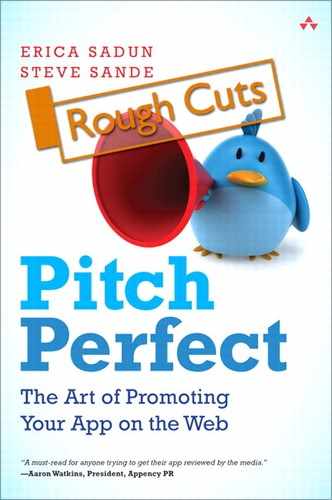5. Case Studies
Good pitches excite, intrigue, and engage. At best, bad pitches may provide amusement to a blogger. The examples in this chapter highlight both successful pitches and ones that could use improvement. You’ll see what works in each of these pitches and what needs a bit of attention as we share real-world examples of pitches from our inbox.
We tried to cover a variety of instructive situations in this chapter. We’ve obviously added a few cases to share some smiles, but we’re hoping these examples also convey deeper lessons.
Each of these case studies represents a real pitch for a real product in a real situation. Businesses depend on these pitches. There are developers who have spent considerable time creating the products they’re writing to us about. You may be surprised that we were, in fact, interested in some of the less perfect examples that crossed our desk.
We responded to machine-translated awkwardness, we’ve bit on pitches that left out critical pitch elements, and passed on pitches that were extremely well written. We included this chapter to provide a real-life grounding to contrast with the do’s and don’ts covered in the previous chapter.
In the end, form matters, but only so much as it helps convey your message. We’re always far more interested in the product you’re trying to communicate about than how you put it in your email. All those tips and tricks we cover throughout this book should help you become more effective at sending that message. Ultimately, your product and its capabilities is what we’re looking for.
Case Study: Short but Sweet
The following is an excellent pitch from Lucidus Apps for its Translator+ Mac App (see Figure 5-1). It doesn’t include all of our recommended elements, but it sells itself without any excess work. It leverages a brief, memorable description to communicate just enough details to get the job done.
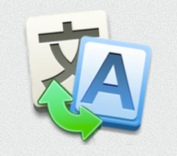
Subject: Please review our Translator+ Mac App.
Here is the Mac App Store promo code for you: XXXXXXXXXXXX
(App Store page: http://itunes.apple.com/us/app/productname/id445180990?mt=12)
Translator+ is the simplest translation tool to help you get a word or paragraph translation instantly. Powered by Microsoft® Translator, it supports 34 languages and gives you accurate translation.
Select. Translate. It’s that simple.
There’s really not much more needed here to grab a blogger’s attention, although the subject line could be more descriptive. The pitch provides a promo code and a link to the App Store page. The summary is precise, and the final catch phrase sums up the product for sale.
Well done indeed.
Case Study: The Solid Query
Despite a few issues with proofreading, the following example from Softsign (see Figure 5-2) shows a good, solid query. The app description is particularly strong. Once read, you know exactly why the product is valuable and where it fits into a usage niche. It also provides a human voice, highlighting the person behind the development.
Figure 5-2. Softsign for iOS allows users to sign PDFs with their fingers.

I wanted to let you know about an App we have developed in case you were interested in writing a review?
Softsign is an App which allows users to sign PDF documents and JPEGs on screen (with your finger or a stylus) and then email them directly from the App - eliminating the need to print, sign and scan documents. It’s legally binding and we are seeing strong traction from the SME community here and in the US and Europe (35,000 users after two months).
You can download the App for free here: http://itunes.apple.com/gb/app/appname/idxxxxxxxxx?mt=8&ls
If you need any more information please don’t hesitate to contact me. If it’s not of interest then thank you for your time.
I look forward to hearing from you.
Not only was this a successful pitch, we really liked the app upon reviewing it.
Case Study: The Professional Pitch
There’s a reason people hire PR firms. They do marketing every day, providing both introductory pitches and full press releases. Consider the following material prepared for an iOS game called Smoody (see Figure 5-3) by Chi Zhao when she worked at Appular PR.
Figure 5-3. Smoody’s update caught our eyes.
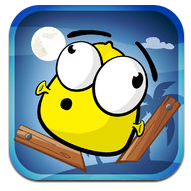
This email introduces a major application update and short-term sale, a great combination for getting bloggers to take a look after a successful initial launch. Zhao has included all the information needed to describe the app (“colorfully animated physics-based iOS game”) and to explain what’s new (via bulleted points). To support this message, she included an assets attachment, links to a video, pricing details, and so forth.
The announcement is sparse and to the point, without wasted effort. This is the kind of communication you should try to mimic.
Smoody Updates with new Levels
With over one million downloads in a single week following launch, Smoody became an instant hit on the iOS platform, and was the #1 top downloaded app in the US App Store.
Today, Smoody announces the release an update for their colorfully animated physics-based iOS game! It now includes five different environments with over 100 mind-bending levels!
Update Includes:
• 20 new levels in an underwater chapter, The Ocean
• Five new characters to discover
• Game Center and OpenFeint leaderboards and achievements
• Facebook and Twitter integration
I have included a copy of our press release along with video and image assets below. Feel free to let me know if you’re interested in reviewing this app!:) Watch the Trailer: http://www.youtube.com/watch?v=zjFm3SQw0ok
To celebrate this launch, Smoody and Smoody HD will be available for FREE on the iTunes App Store:
Smoody for iPhone and iPod touch: http://itunes.apple.com/us/app/smoody/id421953010?mt=8#
Smoody HD for iPad: http://itunes.apple.com/us/app/smoody-hd/id429274014?mt=8
Normally, they’re available for $0.99 and $2.99, respectively.
Best, Chi
Case Study: The Lost Holiday Opportunity
The app developer in the following letter does one thing exactly right. He tied his product release to an upcoming holiday, allowing him to leverage blog coverage. Blogs love covering holiday apps for New Year’s Day (resolutions, health and weight loss), Valentine’s Day (dating apps and apps for couples), St. Patrick’s Day (beer apps), Shrove Tuesday (pancake apps), and so forth throughout the year. If you can tie your app to a holiday, it’s an excellent way to pitch it to websites.
Hello,
I am the developer of a [topic] app for the iPhone, iPod Touch, and iPad. The app is called [product name] and I was wondering if you could mention it on your website for [upcoming holiday]. I would greatly appreciate if my app could be mentioned on this awesome site.
Thank You very much!
[Developer name]
What this developer fails to do here is motivate his application in any other way. He doesn’t explain how his app works in the context of the holiday or provide any of the basic links and descriptions that would sell the concept further. What’s missing is “This is the perfect app for this holiday because....” Go beyond the holiday name into a direct tie to its celebration.
Never assume that your reader will immediately “get it.” It’s worth taking the time to explain and motivate, even if your app is a Jack-o-Lantern for Halloween. Take a few lines to explain how your app works within the holiday context and how it stands out from the crowd. This is a real lost opportunity, because he offers the right kind of app at the right time of year, but without a few supporting lines of information that would help promote it effectively.
Don’t forget the extra work involved here for the blogger. There are no URLs to any product page whatsoever. The blogger will need to start tracking down the app manually to see if it will be a good match to the holiday coverage.
Case Study: The Meh Pitch
Your application write-up should pop. It should excite potential reviewers just as much as it excites you. After all, you just spent however long sweating over its development. Here’s an example of a pitch that just didn’t engage us.
Our company just released a new iPhone game called [Product Name] which is available for free on AppStore. This is very simple time killer but it features unique and very charming creature [as named].
When the game begins the player places their finger over [product feature] and waits until [an event occurs] at which point the player should react quickly by [responding to that event].
We would like to ask you if you could do a review of the game on your web site.
The problem with this pitch lies in how dull the application sounds. It’s a game app, but it doesn’t inspire fun. Where’s the excitement? Where’s the hook? Contrast that pitch with how it could have been. Here’s how we envision trying to sell the exact same app, but with a little pizzazz.
Watch your fingers! You don’t want to lose them to [the charming creature]!
[Product name] introduces a fun and exciting assessment of your reaction time. Think you can best [the charming creature]? Put your skills to the test with this free app, now available from the iTunes App Store.
Yes, our rewrite isn’t ideal, but it introduces the notion of challenge and excitement that’s distinctly lacking in the original. This revised pitch uses its introduction to grab attention and follows it up with a motivational statement that explains why the app stands out.
Always ask yourself, “What is my app’s big idea?” Use that idea to help your app stand out and intrigue the reader.
Case Study: The Completely Inappropriate Pitch that Made Us Smile
Sometimes, a mismatched pitch can still win a blogger’s heart. The following software was in no way an appropriate match for the website, yet we were utterly charmed by the letter. Its English is awful but at the same time, the pitch pops. You know exactly what this application offers and who its audience is. The author’s enthusiasm projects past any language barriers (or issues of squickiness). No matter what you think about apps of this nature, the gusto shines through.
Dear Sir and Madam
I’m writing for request a review of our photobook app. We are delivering many apps in Japan. We would like to expand our market in USA as well. We have already delivered some apps in USA app store. I’m requesting the app review to your website.
Here is [name]; Japanese hot gravure babe photobook. She is known as a gravure idol in Japan. Her attract point is a big breast. It is going to come out from her bikini..... She is in a island in this photobook and playing around at the beach. She also exploring in the forest. You can feel you are traveling in the island with her. Enjoy her sexy posings and smiles.
Downloading and browsing bikini photos by iPhones and iPods are available. Downloaded 100 fabulous photos.
It is not allowed under 17 years old to download this pics.
Definately don’t make you regret to purchase this photobook. Don’t miss it!
3. iPhone app link; http://itunes.apple.com/us/app/idxxxxxxxx?mt=8
I hope you would put this apps to your website. Please do not hesitate to contact me at any time.
Sincerely, [developer name]
To this day, “attract point” has become our insider meme for don’t-miss application features.
Case Study: Winning by Charm
Some pitches win us over with simple charm. That said, we have about as much interest in cord detanglers (see Figure 5-4) as we do in sheep intestines. But, how can anyone ignore a pitch as clever and on the mark as this one? We loved it.
Figure 5-4. The Recoil Cord Winder.
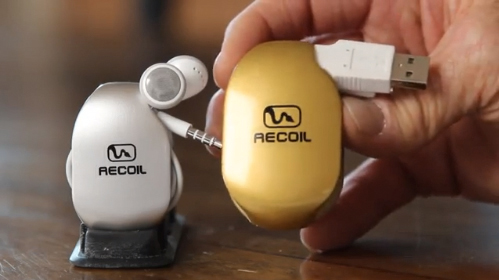
Dear TUAW,
There are moments in history when a particular person in a particular place has the chance to re-direct the course of humanity.
In 460 BC Hippocrates launches the age of Modern Medicine.
In the 1600’s Papin perfects the Steam Engine
In 1928 Alexander Fleming invents penicillin.
In 1976 Bill Gates ushers in the era of Modern Computers
In 1965 James Brown invents Funk.
Now, in 2012, TUAW has the opportunity to impact humanity on a near similar scale. Through the power of TUAW’s epic influence over the clicking pattern of it’s readers, TUAW alone can save humanity from the inevitable collapse of modern society due to the overwhelming accumulation of tangled cords and cables which is at the root of so much human despair.
Cordpocalypse!
By following this link: http://kck.st/xZHQRk, and exposing your readers to the revolutionary technology contained therein, the name TUAW is likely to be included in the history of human achievement reserved for only the true visionaries.
Thank you for your courage, and your focused determination to put the future of our species above whatever current editorial schedule you might already have in place.
Humbly in your debt,
David Alden
David’s pitch was smart, funny, and it sells his product (in this case, a Kickstarter project) far better than “please look at my cord detangling solution.” To be honest, we did end up passing on this project, but it wasn’t because his pitch failed; it was due to the product itself. There’s only so much enthusiasm for cord technology we can muster, no matter how brilliant the pitch.
Case Study: Completely Missing the Mark
Sometimes, a pitch just gets it wrong, all wrong. From the topic of the pitch (“Android applications”) to the auto-translated language used within, this pitch reflects a low level of detail oversight.
We development android applications “NIPPON MELODY MAKER”
Nice to meet you. My name is K. M. We have been producing music and video and application development in Japan. This time, I made a music distribution application. A lot of Japanese anime theme song. It revives all types of music from latest to old favorite of Japanese anime theme songs. It is one of the free downloadable music synthesis application of media player and the music store. All the purchasable music of our store are high quality.
Please check my URL (Not included) Thank you Kind regards
That’s not to say that poorly targeted pitches are limited to foreign requests. Here’s one that didn’t understand that TUAW doesn’t review Android products.
I am co-founder of [redacted]. We have recently published our first game called [redacted]! We are launching it for Android here in the next week or so, and I was wondering if you guys would check it out for an App-a-day review or something! We would be more than happy to send a few promo codes your way! Please let me know if this is not the proper channel for this, as we are just getting off the ground, but would love to share this addictive retro-style game with you!
Thank you for your time!
Make every pitch count. Consider who you are sending the pitch to and why it’s a good match to their website.
Case Study: The Perils of Autocorrect
Here’s a pitch that introduces a “fermium model solution.” What’s the app doing with that synthetic element (see Figure 5-5)? The developer probably meant “freemium,” the business model where apps are offered for free with premium purchases leveraged after that initial sale. The lesson here is this: Beware of autocorrect!
Figure 5-5. Autocorrect is not your friend. Fermium is a synthetic element. Its symbol is Fm and its atomic number is 100.
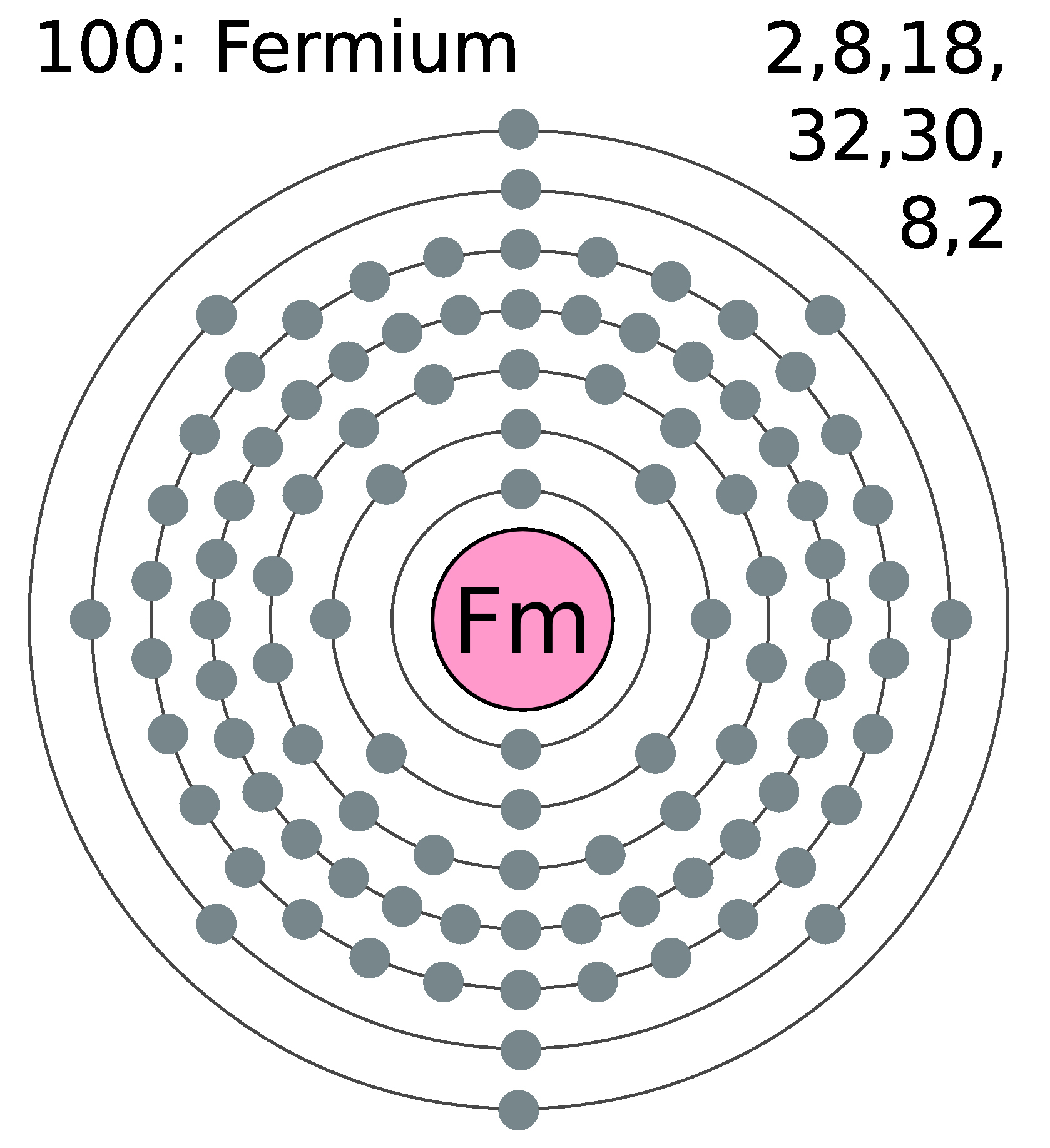
We have created a really cool new app that is a fermium model solution. For free users can add documents that they want to keep with them on their iPad or iPhone. For $.99 they can use the app as a better FAVORITES button for their DropBox or Google Docs documents. And for $20 a year--they can keep documents in-sync with other devices, share easily with users and upload stuff online...
Autocorrect is not your friend, although we think the atom would work pretty well as a low-end (perhaps overly busy) icon.
Case Study: Buzzwords
Some pitches are so full of buzzwords that we have to work too hard to figure out what the developer is getting at. Write simply. When in doubt, put your pitch through a “reading level” calculator. There are dozens available via a simple Google search.
Common readability metrics include the Gunning Fog index, Flesh Kincaid Grade Level, Automated Readability Index, Coleman Liau index, and the SMOG readability index.
You can easily find automated tools to grade your writing. Paste in your pitch and see exactly how hard your text is to understand on its first reading. For example, consider this pitch.
[Redacted] is a dedicated browser that lets you preview, edit and screenshot your responsive site at any size from mobile through to large desktop. Focus your responsive workflow with a tool that doesn’t rely on bookmarklets, restrictive pre-defined breakpoints - or even a web connection. [It] improves on web-based tools by letting you create and work on multiple breakpoints simultaneously, even setting custom user agents if required. [It] also allows you to preview and debug fluid variations inside your media queries with our unique “Range” functionality - all without having to resize your browser ever again.[It] allows you to capture full viewport screenshots of all open breakpoints for sending to clients, supporting blog posts or assessing layout. Of course [it] doesn’t require a web connection so you can work uninterrupted when traveling or when a connection isn’t available.
Or this one:
With the pressure to validate an increasingly complex set of testing requirements across different applications architectures and interfaces, multiple mobile OSs, form factors, and network technology layers, [we] forecast cloud and mobility applications will help propel worldwide testing services to an impressive 15.4 percent annual growth rate through 2015.
Would love to wire you into this announcement and discuss this new cloud sync functionality to enable greater collaboration and synchronization with ease between developers and all project stakeholders.
If a pitch requires a graduate level of education to read comfortably, you probably want to re-write it to make it simpler, friendlier, and more comprehensible.
Aim for a reading difficulty below 8th grade. You won’t insult the bloggers; you won’t insult the customers reading your marketing text. Detangle your writing and your audience won’t have to process complicated sentences.
Figure 5-6 shows the score for the above pitch snippet. The webpage used to calculate these numbers states, “The measure of readability used here is the indication of number of years of education that a person needs to be able to understand the text easily on the first reading.”
Figure 5-6. Simplify your writing. Readability indicators can help you judge how you’re doing.
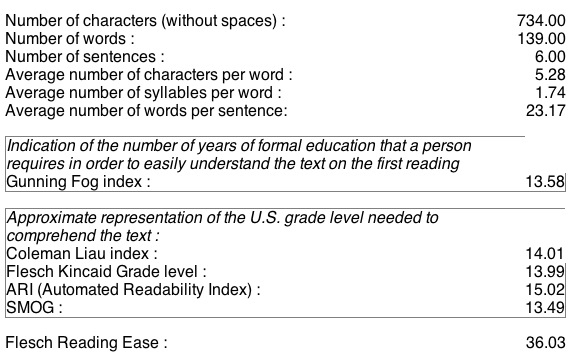
Case Study: Not Enough Detail
Sometimes, simplicity isn’t enough. Although the intent is worthy, the developer fails to offer enough information to make us want to use that promo code he sent along.
Subject: our new app
We’ve released a new app and would love if you review or comment on it.
Here’s a promo code: N3Y6739AJN43
Here’s another one, which at least mentions the name of the product and its category.
Hi,
could you please review my memory game, [Product Name]?
Thank you
And another, which offers us, well, nothing.
Subject: I need a review
I have app to submit
In many cases, less is more, but don’t take it to the extreme. Always give bloggers something to go on. Unless you provide that structure to explain your app, your pitch is heading straight to Mail’s trashcan.
Case Study: The WTF We Don’t Even Pitch
Death can be set only when all the timer is not running.
[Redacted] is a simple app that only four timer. Kitchen timer, photo film developing, learning presentation, please use to demonstrate the speed of imagination, such as eating contest hot dog.
You can set the “second” and “minutes” in the screen for each timer. Four timers will operate separately. It is also possible to operate four successive timer. Continuous mode switching, please click the Settings icon. Death can be set only when all the timer is not running. Sound when the time is up.
1. Bell 2. Harp 3. Game Clear 4. Bow 5. Vibe (no sound)
We know. Us, too.
Case Study: The Pitch that Got Away
We received the following pitch in Autumn 2012 and replied, hoping to take a look at the product. And then, we never heard back from the developer. Yes, the pitch sounded a bit odd with its uppercase APP mentions and stilted tones, but it sounded like one that might be of interest to a segment of our readers.
Dear Sir or Madam:
I have recently created my first “APP”. I would be extremely grateful if you would review my APP. This would be invaluable to its success.
The APP is called OCD, which stands for Obsessive Compulsive Disorder. This is something that I have researched in great detail both as a Radiographer and Nurse, and as a previous sufferer. It is estimated that a significant proportion of people will suffer with OCD. It is also a factor in many disorders and social issues, as my research will demonstrate.
My APP contains a clear and concise description of OCD, has a test to ascertain the level of OCD being suffered, and includes treatment options. The APP provides Cognitive Behavioral Therapy, the leading treatment for OCD, among other issues.
My app is considerably cheaper that its competitors.
Please consider my APP for your publication.
Cognitive Behavioral Therapy (CBT) is an area in which several bloggers on our team have a background and interest. We regularly cover topics about assistive technologies and creative uses of Apple technology for age and physical challenges. Although the phrasing is odd, and the author may or may not be a “previous sufferer,” it’s a topic that caught our interest and one that we wanted to pursue but couldn’t.
Case Study: Don’t Submit Multiple Products All at Once
This is not a hard and fast rule actually, because we do respond to multiple product requests most typically from hardware developers. It’s common for them to suggest that they send us a group of items to test. However, we do not treat product submissions as “tickets.” We don’t open a review queue to investigate each request. Therefore, you’re generally best off individually submitting each app you’d like us to review.
Of course, it’s also best to describe and name the apps in question in your pitch. Sadly, the developer who sent along the following pitch did not.
I would like to submit these 3 iOS app reviews to tuaw.com:
http://itunes.apple.com/us/app/....
http://itunes.apple.com/us/app/....
http://itunes.apple.com/us/app/....
Thank you
Related URL: http://
Case Study: Machine Translation
Imagine trying to sell your application in a foreign country, one whose language you do not speak. TUAW blogger TJ Luoma asked us to include this tale of a young Italian app making its way in a far-away land via a machine-translated pitch that was just coherent enough to catch our interest.
Hello, I’m writing to announce my new application with which you can not miss the most: Has it ever happened that the phone will ask where you are and you do not know the way? Or do you need to know the zip code of the area and you should always ask someone? with this, you can see exactly who you [URL redacted]
The pitch, as hard to understand as it was, did sound interesting. So, TJ clicked the App Store URL to get more information about the app. What did he find? An app description in the U.S. App Store written entirely in Italian, as shown in Figure 5-7.
Figure 5-7. Non si parla italiano.
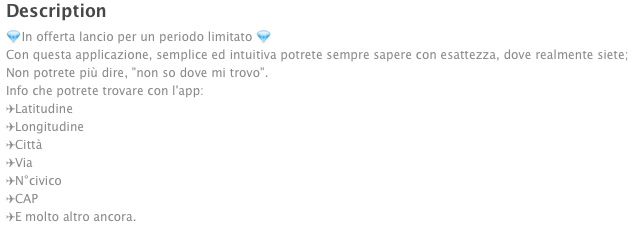
As many independent developers are popping up all over the world, this type of pitch and product description situation is becoming more common than you might first imagine.
Whenever possible, especially when requesting reviews from major American blogs, hire a native speaker (Google Translate doesn’t count) to produce English-language marketing materials for your App Store entries and, hopefully, your pitch letters.
We think that this is an app we’d have been interested in. Unfortunately, the communication barrier proved insurmountable.
TJ notes, “Make sure your app description page is in a language that can be read by the people you want to review it. If you hope to reach a wide audience, make sure it’s available in English -- the de facto lingua franca of the Internet.”
Case Study: Avoid Unspecific Bullets
Bullet points push key features that should catch bloggers’ and purchasers’ eyes. They are a major structural element for many pitches, letting you offer tasty selling points with minimal words. You see them so often because they work so well. A well-designed bullet list condenses reasons people should buy a product into a single visual stack.
When added to your pitch, make sure they present information that differentiates your product, not just describes it. Each bullet point should pop with a great sales idea. Here’s an example where a pitch went wrong with its bullets.
Hey Blogger,
I have a product you might be interested in checking out - It’s a really cool and practical program that helps people keep and plan their trips in a better way, and has the following hot features
1, Ease of using.
2, User friendly and clean interface.
3, The first kind of truly travel route planner......
You can get some more information from our product site.
And if you think you might be interested, drop me a note and I’ll forward you something. Thanks for taking time to read this mail. I look forward to hearing back from you.
Regards,
Sadly, none of these bullets stands out to sell the product. Worse, point 2 merely restates point 1, and neither explains how the product offers a unique user experience that sets it apart from the field. Plus, we can assure you that we’ve seen lots of “truly travel route planners” in our time.
When you include lists in your pitches, make sure each point motivates and sells your “hot features.” For example, the developer here might have pushed “an amazing user-centric design,” maybe one that “limits the number of touches used to select a route,” or “a planner that adapts to your user’s itinerary, not just his destination.” There are lots of ways each point could have been expanded and explained.
Case Study: The Excellent Response
We often reply to pitches with queries when we don’t quite get how the product fits into its competitive field. For example, we received a pitch from Charles Teel about his ActivePrint app. He wrote, “After a great deal of input from Mac users, we have just released a beta version of our popular ActivePrint app for the Mac OSX platform.” Erica responded, asking, “We’ve covered quite a lot of these in the past—how does your app move past Printopia features to offer something compellingly new?”
This is where Charles did an amazing job. Unlike many other developers who respond to these kind of queries by repeating the same information from the original pitch, he wrote back with a thoughtful and incisive description differentiating his product from the competition.
Excellent question! When compared to Printopia I would say that ActivePrint’s unique feature is range. Basically Printopia will make any printer an AirPrint printer. However, the limitation of AirPrint printers is that your iPad or iPhone has to be on the same WiFi network as the AirPrint printer. As a result, this is tethering you to your home network if you want to print. To me, that kind of defeats the purpose of being mobile with these kinds of devices.
With ActivePrint, you get the advantage of our Cloud Printing service. This allows you to not only print to your PC’s printer while you’re geographically near it, but also while you’re across town or across the world. All you need is an internet connection for your iPad or iPhone. As an example you could do work at home on your iPad, and have the document printed on your office printer across town. Or if you’re on vacation and you take photos with your iPhone, you can send those photos to your printer back home right after you take the photos. In both scenarios, you’re not having to wait until you’re near your printer to print your content. Instead, your content is waiting for you in your printer tray by the time you get to your office the next day or back home after your vacation.
With AirPrint solutions like Printopia, you have to wait until you get home from vacation and then go through the process of deciding which photos you want to print. Or in the work from home scenario, wait until you get to the office and try and remember which documents you needed printed. After you’ve done, then you have to wait for the printing to complete. While you’re going through all of this, you could have already had it all waiting for you in your printer tray when you showed up if you had ActivePrint.
His correspondence explained the way his product fit into the market and showcased its abilities and potential.
He got his review.
Case Study: The Pitch Rewrite
Although most pitches aren’t awful, many can be improved upon with a little work. Brian Atz of Essential App Marketing is a tremendously good sport. He allowed us to take one of his real-world pitches for iDashboard, break it down, and suggest improvements for the purpose of this book.
Figure 5-8. iDashboard for iOS.

The Original Pitch
Here is Brian’s original pitch, with our commentary interspersed, so you can see some of the kinds of issues that typically arise along with our suggested fixes.
Dear Erica,
Salutation is appropriate and friendly.
My agency, Essential App Marketing, is working with BolderImage to promote the release of a very exciting iPad application called iDashboard.
We felt this focus on the agency and BolderImage was misplaced. Every app better be exciting; otherwise, bloggers aren’t interested. We recommend removing the intro sentence entirely. The app’s price point is missing.
Not including the price in your pitch is a big error. It may give bloggers the impression that you don’t think your app worth the price you’re asking. Perhaps you think that making people go to the site to find out the price is some sort of enticement to get them to look at your app. (It isn’t.) Always include the price upfront because it tells potential reviewers an important part of your app story.
iDashboard is a BRAND NEW iPad app that enhances your productivity by turning your iPad into a complete information center with calendar notifications, RSS newsfeeds, local weather, Facebook, Twitter, and iPod music, all on a SINGLE SCREEN!
These capitalized letters don’t work well as emphasis. We’d rewrite to “iDashboard transforms your iPad into your core personal information center. View your calendar notifications, etc., all on a single screen.”
As is, this text defines what the app does but doesn’t motivate it. There has to be a hook sentence that personalizes the product and tells the user why they should care. Plus, more content on a SINGLE SCREEN doesn’t sell the product. Here’s also where a screenshot can tell the story better than the text.
Don’t just charge your iPad, transform your docking time into a ONE-STOP MULTI-MEDIA INFORMATION CENTER - Keep an eye on your calendar, listen to your favorite playlist, and watch breaking news and sports. Your iDashboard is COMPLETELY CUSTOMIZABLE for your social profiles, favorite blogs, family photos, and more.
Now finally, the actual reason to be interested. Unfortunately, it’s buried three paragraphs down from where it would be most effective. Ignoring the capital letters, here is the heart of the pitch—finally—and what should have started it out.
The “Don’t just charge” sentence (with decap therapy) is actually a strong way to sell the app. We’d skip everything up to this paragraph except the salutation.
Erica – I’ve included 4 links below with more details on iDashboard:
This sounds robotic, we’re afraid. We don’t really care how many links follow below. We’d delete this sentence entirely and let the links speak for themselves. Plus repeating the name here (“Erica”) feels second-hand-car-dealer-y: just a tad slimy and forced. We’re sure that wasn’t the intention, but it comes across as inappropriate.
App Link: http://itunes.apple.com/us/app/id453719557?mt=8
Press Release: http://www.idashboardapp.com/press-room/
Screenshots: http://www.idashboardapp.com/
Demo video: http://www.idashboardapp.com/demo/
If you have any questions, please contact me at [phone] or [email].
Polite and courteous contact info here, although he forgot to offer promo codes.
Thank you! -- Brian
Brian Atz, CMO, Essential App Marketing
Here, he forgot to repeat email and phone and include full contact address.
In other words, this was a pretty good pitch to begin with, but one that lost itself by burying its lede and leaving out key information.
The Rewrite
Taking all these criticisms into account, we could strengthen his pitch by condensing it and punching things up right from the start. Here’s our suggestion of how a stronger pitch might read.
Dear Erica,
Don’t just charge your iPad. iDashboard ($9.99) transforms your docking time into a one-stop multimedia information center. Keep an eye on your calendar, listen to your favorite playlist, and watch breaking news and sports. iDashboard is completely customizable for your social profiles, favorite blogs, family photos, and more.
App Link: http://itunes.apple.com/us/app/id453719557?mt=8
Press Release: http://www.idashboardapp.com/press-room/
Screenshots: http://www.idashboardapp.com/
Demo video: http://www.idashboardapp.com/demo/
If you have any questions, please contact me at [phone] or [email]. I’d be happy to shoot you a promo code upon request.
Thank you! -- Brian
Brian Atz, CMO, Essential App Marketing
[contact information repeated, including physical address]
Thank you, Brian, for being so kind about letting us include this!
Case Study: Remembering that the App Is the Hero
Here’s a snippet from a PR agency for a recent iOS application.
I would like to inform you that (App Name) is now available on the App Store: (unlisted YouTube clip)
I’d like to invite you to take a look at our websites so you can see how powerful and feature-rich this application is (Website Link)
This pitch has several problems. The over-formal language (e.g., “I would like to”) and passive voice are just the start. Every sentence in the pitch introduction (you’re only seeing the first lines of a very long email) began with “I.”
Remember this when pitching your apps: The hero is the app itself, not the person pitching it. There’s nothing wrong with speaking in the first person, so long as you keep focus on the app and talk about what that app does. Consider the following adaptation of this pitch:
(App Name) is now available on the App Store. See it in action here: (unlisted YouTube clip) or visit our website to explore how powerful and feature-rich this application is (Website Link)
That’s not saying this is a great app pitch, but it’s better than the original because the focus has moved away from the PR person who is pitching it.
Take care to avoid passive voice. Use a spell checker and grammar checker. The pitch continues.
(App name) is an evolution of the native iOS music playback application. It’s simple, yet powerful interface which allows you to control, browse, list and listen to your music intuitively. (App name’s) operation has a natural and ergonomic feel, which will be picked up instinctively.
Convert passive declarations (e.g., “is an evolution”) into active ones. Here are a few fixes that might have helped this pitch.
(App name) evolves the iOS music playback app. Users control, browse, list, and listen to music intuitively. (App name) uses a natural, instinctive, and ergonomic GUI.
Marketing text is an art, one that relies on exciting the reader and keeping the ideas simple. When possible, try to re-edit your releases to keep these goals in mind. Here are a few pointers to keep in mind.
• Spell-check and grammar-check your release.
• Avoid passive voice.
• Make your application the hero of your write-up.
• Trim away excess text to get your point across succinctly.
• Have other people read your release before sending it out.
Case Study: The Twitter Pitch
Sending us a direct tweet isn’t a great way to request a review (see Figure 5-9). That’s not to say we don’t respond to Twitter or engage with developers there, but there’s something immediate and conversational about Twitter. Pushing into a conversation (or worse, starting one) with a pitch feels intrusive.
Figure 5-9. Please send email or submit your review request directly to websites.
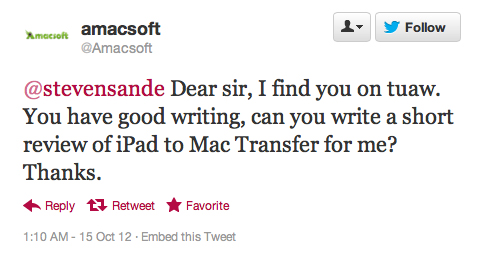
We prefer you to send email or to submit your requests through the normal website.
Final Tips: Avoiding Grandiosity
Some writing habits predictably annoy bloggers. The problem is that so many words cross our desks in any day that lazy pitch writing, especially writing that employ grandiose claims, calls attention to itself via repetitive phrasing. Take time to differentiate your descriptions from the crowd and be rewarded by a more receptive audience. The following are our standard suggestions on these matters.
• Don’t overuse the word “unique.”
If every product is “unique,” none of them are. Unique means the only one of its kind. For a product to be unique, it must be singular, unlike anything else out there on the market.
Point out features that make your product stand out and talk about how they help users rather than focusing on “uniqueness,” particularly those products that are “especially unique,” “extremely unique,” and “the most unique”.
• We have just released this weekend a very unique app that lets you create, design and share your own moods, smileys and emoticons on your iPhone and tag people in them.
• [Product] is an unique service that let users order exclusive, hand-drawn caricatures from their very own photo! It’s a unique app, with no analogues in the App Store.
• The [Product] Stand is a unique 3-in-1 multipurpose case for the iPhone 5 with the following features
• Available in 8 languages, [Product offers] 6 unique gameplay styles, and dozens of iconic characters in a western adventure for mobile devices like no other. Try it today!
• this is a free and unique experience as one of the best app in its category with no others in the AppStore.
• Your product is probably not “innovative.”
Like “unique,” “innovative” is tremendously overused in blog pitches. Innovative means a product features ideas that are new, original, and creative. Think carefully before making this claim.
Your poker game, your tip calculator, and your phone case are unlikely candidates for innovation. They may be well made, well designed, and highly functional, but ask yourself, “Are they really bringing something new to the world that hasn’t been seen before?”
• I have created an innovative laptop case that uses revolutionary new materials to achieve a level of protection never before seen in a case this light and stylish
• [Product] was born to challenge the rules of classic pen design by combining innovation, and performance to create the most inventive writing instrument
• We are thrilled to announce our newest innovative photo/video accessory
• This innovation is renewing one of the most famous effect of the gaming world: the parallax effect
• I wanted to tip you to an innovative app I developed that represents a modern take on the hand turkey.
• Local multiplayer gaming is provided with an innovative pass-the-pad feature, allowing players to compete on the same device.
• Limit your superlatives.
Is your product truly a “game changer?” Is it so visionary that the entire industry will redirect itself after its debut, re-envisioning how things are done, thought about, or made? Probably not.
In a similar way, your product may not be “groundbreaking,” a synonym for “innovative” or “state of the art,” representing the highest level of current technology. And while many games seek to be “addicting,” few actually are.
“Technically you could just take all of the superlatives, string them together in a sentence in any order and have a full PR release at your hands.” – Michael Jones, TUAW
“You keep using that word. I do not think it means what you think it means.” -- Inigo Montoya, The Princess Bride
Wrapping Up
In this chapter, we used real-life examples to point out both well-written and not-so-admirable product pitches. When you’re working on your pitch, think about every phrase you write. A few things you should have learned here include the following:
• Keep it short. When a blogger has hundreds of emails to read every day, it’s best to condense all the details about your product—especially the price, purpose, and unique aspects—into as few words as possible. Be pithy.
• Keep it simple. Focus on communicating in clear straightforward language instead of overwhelming us with superlatives and buzzwords.
• Show bloggers your personality. A little charm and humor can go a long way toward attracting the attention of a busy blogger.
• If English is not your native language, be sure to run your product description and pitch past a native speaker before submitting either to a blog.
